High Level Summary of Equality Statistics: Key Trends for Scotland 2006
The High Level Summary of Equality Statistics is a compendium which presents statistical trends on the main areas of Government activity in Scotland across a number of equality dimensions including age, disability, ethnicity, gender and in some cases religion. It provides a standardised, concise format for each topic and provides a route into more detailed statistics on each topic and each equality dimension by listing relevant publications and websites.
10. Crime & Justice
Introduction to Crime & Justice and Equality
This section of the High Level Summary of Equality Statistics ( HLSES) presents key information on crime and justice in Scotland across a number of equality dimensions including age, disability, ethnicity and gender. It reflects key areas of activity identified in the main High Level Summary of Statistics ( HLSS) chapter on the crime and justice ( http://www.scotland.gov.uk/Topics/Statistics) from an equalities perspective and includes a few additional topics where these are particularly relevant to equality issues. Where the main HLSS publication presents data by any of these equality dimensions, these are also shown here for ease of reference.
As well as showing key high level trends, the analysis highlights where differences and potential areas of inequality may exist in terms of crime and justice in Scotland for those groups outlined above. The analysis is not intended to provide a definitive set of equalities data and more detailed statistics across the equality dimensions, where available, are referenced in the links provided. It is also not possible to break down all topics by all equality dimensions.
There are limitations in how far some data can be broken down by the above equality dimensions. Data often contain small numbers, particularly in the case of smaller ethnic groups and to some extent disability. As such, some data show a high degree of volatility. In such instances, data may have been combined for multiple years or multiple ethnic groups, whilst in other cases data may be shown for a single year only. In other instances small data may have been suppressed in order to protect individuals' confidentiality
Possible reasons underlying the differences reported in this chapter are not detailed here. Factors which contribute to differences between equality groups represent a complex interplay of cultural, demographic and socio-economic factors and, as such are outwith the scope of this publication.
Crime and Disorder
Crime and Disorder
Re-offending
Age & Gender
Among the cohort of offenders who were discharged from custody or given a non-custodial sentence in 2002/03, the overall two-year reconviction rate was 45%. This rate was highest for offenders who were discharged from custody (64%), male (47%), aged under 21 (54%) or who had over 10 previous convictions (76%).
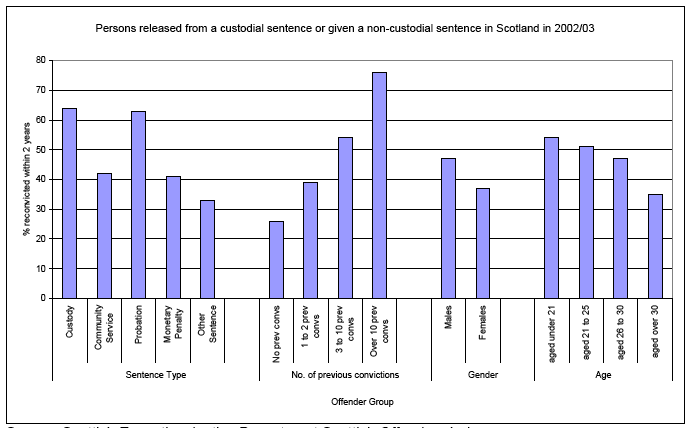
Source: Scottish Executive Justice Department Scottish Offenders Index
Publications
Social Focus on Women and Men 2002 http://www.scotland.gov.uk/stats/sfwm/docs/sfwm-00.asp
Reconvictions of Offenders Discharged from Custody or Given Non-Custodial Sentences in 2002/03, Scotland (Published 2006) http://www.scotland.gov.uk/stats/bulletins/00534
Police Strength
Police Strength: Gender
There are markedly more male than female police officers and special constables serving with the eight police forces in Scotland, although this gap continues to narrow.
In terms of Whole Time Equivalents ( WTEs), male officers (12,797) outnumber female officers (3,367) by almost 4:1 as at December 2005. However this gap has narrowed over recent years and compares to a ratio of approximately 5:1 as at December 2000. This reflects the fact that since December 2000, the number of officers ( WTEs) has increased more sharply for females (997 additional officers, a rise of 42%) than for males (377 additional officers, a rise of 3%).
Based on headcount figures, male special constables (816) outnumber females (380) by 2:1 as at December 2005. However this gap has narrowed over recent years and compares to a ratio of just under 3:1 as at December 2000. However this more strongly reflects the decrease in the number of male special constables during this time than the increase in the number of female special constables.
It should be borne in mind that, in general, females are more likely to work part-time than males and as such this is likely to have an impact on WTE figures i.e. these are likely to be higher for males than females. This does not apply to headcount figures, which includes both part-time and full-time employees.
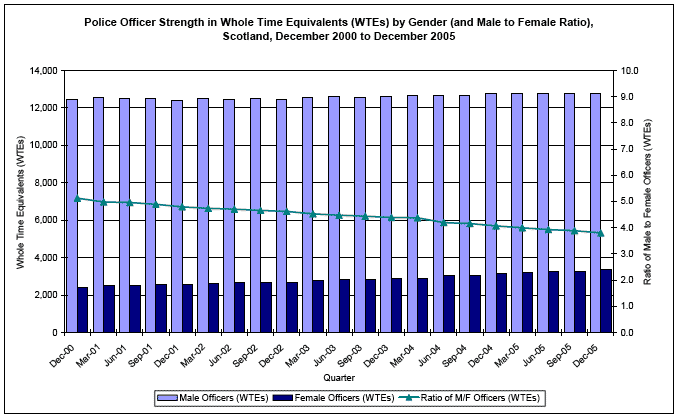
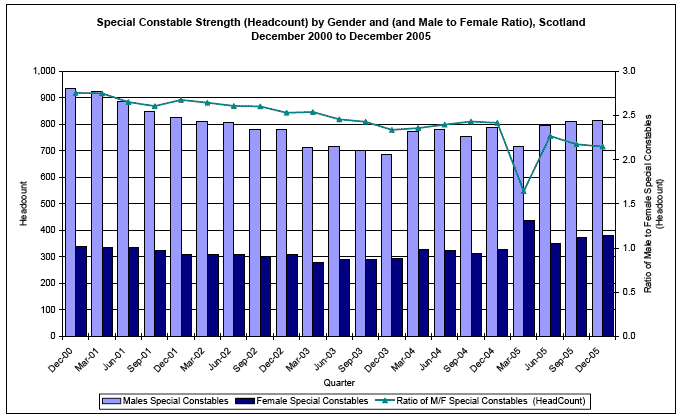
Source: Scottish Executive Police Division
Publications
Social Focus on Women and Men 2002 http://www.scotland.gov.uk/stats/sfwm/docs/sfwm-00.asp
Annual Report of Her Majesty's Chief Inspector of Constabulary for Scotland 2004/05 (Published 2005) http://www.scotland.gov.uk/Publications/2005/10/3192658/26589
Police Strength: Ethnic Group
Approximately 1% of police officers, support staff and special constables were from minority ethnic groups as at March 2005. This has increased from approximately 0.5% as at December 1999. By way of comparison, 2% of the Scottish labour force as a whole were from minority ethnic groups in 2005 (according to the Annual Population Survey 2005).
Police Officers Strength, Police Support Staff Strength & Special Constable Strength, Headcount 1, by Ethnic Group, Scotland, April 1998 - March 2005
Number (Headcount)
Year |
Scotland |
|||||
|---|---|---|---|---|---|---|
Police Officers Strength |
Police Support Staff Strength |
Special Constable Strength |
||||
White Ethnic Groups |
Minority Ethnic Groups |
White Ethnic Groups |
Minority Ethnic Groups |
White Ethnic Groups |
Minority Ethnic Groups |
|
1998-99 |
14,759 |
55 |
5,319 |
29 |
1,632 |
19 |
1999-00 |
14,646 |
70 |
5,425 |
32 |
1,508 |
20 |
2000-01 |
15,064 |
91 |
5,610 |
29 |
1,437 |
12 |
2001-02 |
15,213 |
94 |
5,793 |
30 |
1,256 |
15 |
2002-03 |
15,417 |
100 |
6,207 |
31 |
1,123 |
13 |
2003-04 |
15,560 |
185 |
6,797 |
56 |
1,120 |
15 |
2004-05 |
15,991 |
184 |
7,141 |
66 |
1,173 |
13 |
Source: Her Majesty's Inspector of Constabulary ( HMIC)
Note: 1. Figures are on a headcount basis and therefore include a count of all staff regardless of whether they work full-time or part-time.
Publications
Analysis of Ethnicity in the 2001 Census - Summary Report http://www.scotland.gov.uk7ff5ee0f-3801-4607-b42e-2fbe7a66bf2d
Annual Report of Her Majesty's Chief Inspector of Constabulary for Scotland 2004/05 (Published 2005) http://www.scotland.gov.uk/Publications/2005/10/3192658/26589
Drunkenness Offences
Drunkenness Offences: Gender
Males account for 85% of all persons proceeded against for drunkenness offences in 2004-05. The total number of persons proceeded against for such offences has decreased dramatically over the past decade, most markedly for males.
The number of males proceeded against for drunkenness offences has decreased by 80% from 1,297 in 1994-95 to 263 in 2004-05. By comparison the number of females proceeded against for such offences has fallen by 69% from 151 to 47.
It should be noted that the overall decline in numbers prosecuted for drunkenness offences partly reflects greater use of alternatives to prosecution such as fiscal fines for this type of offence.
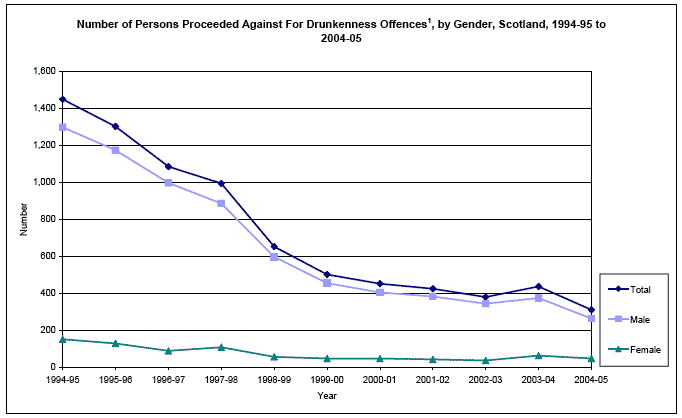
Source: Scottish Executive Court Proceedings Database
Note: 1. Where main offence.
Publications
Social Focus on Women and Men 2002 http://www.scotland.gov.uk/stats/sfwm/docs/sfwm-00.asp
Criminal Proceedings in Scottish Courts, 2004/05 (Published 2006) http://www.scotland.gov.uk/Publications/2006/04/25104019/0
Drunkenness Offences: Age
Over the past decade, the number of persons proceeded against for drunkenness offences has decreased markedly for adults across all age groups.
With the exception of those aged 60 and over, there is little difference in the number of persons proceeded against for drunkenness offences across age groups in 2004-05. However since 1994-95, there has been a particularly marked fall in the number of persons proceeded against for these offences who are aged between 35 and 59 years.
It should be noted that the overall decline in numbers prosecuted for drunkenness offences partly reflects greater use of alternatives to prosecution such as fiscal fines for this type of offence.
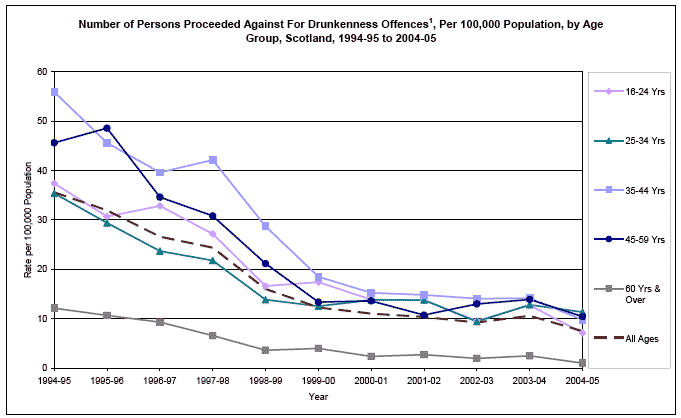
Source: Scottish Executive Court Proceedings Database
Note: 1. Where main offence.
Publication
Criminal Proceedings in Scottish Courts, 2004/05 (Published 2006) http://www.scotland.gov.uk/Publications/2006/04/25104019/0
Crimes of Sexual Assault
Crimes of Sexual Assault: Gender
Crimes of rape and indecent assault have increased over the past decade, whilst crimes of assault with intent to rape have remained fairly constant.
Crimes of rape have increased more than twofold from 469 in 1996-97 to 975 in 2005-06 and over the same period, crimes of indecent assault increased from 1,122 to 1,508 (up 34%), whilst crime of assault with intent to rape have increased marginally from 164 to 186 (up 13%). These figures partially reflect pro-active efforts by the police to encourage the reporting of crimes such as rape and attempted rape, including those which have occurred in the past.
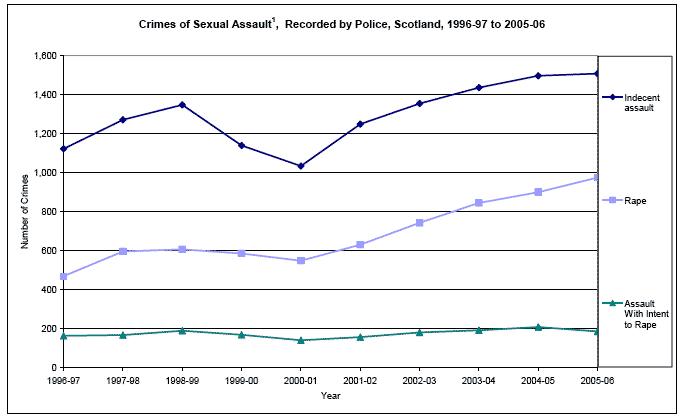
Source: Recorded Crime in Scotland, 2005-06
Note: 1. Under current Scots Law crimes of rape and assault with intent to rape can only be committed by a male (perpetrator) against a female (victim).
Publications
Social Focus on Women and Men 2002 http://www.scotland.gov.uk/stats/sfwm/docs/sfwm-00.asp
Recorded Crime in Scotland, 2005-06 http://www.scotland.gov.uk29fbbb27-50a3-4510-9f5e-2af8cfcd3e67
Domestic Abuse
Domestic Abuse: Gender of Victims & Perpetrators
In 2005-06, the victim was female in 86.1% of incidents of domestic abuse where the gender of the victim was recorded. The perpetrator was male in 86.1% of incidents where the perpetrator's gender was recorded.
The percentage of incidents of domestic abuse where the victim is female and the perpetrator is male has gradually decreased since 1999-00.
Incidents of Domestic Abuse Recorded by the Police, by Gender of Victim and Perpetrator as a Percentage of Incidents,Scotland, 1999-00 to 2005-06
Column Percentages & Number
Gender of Victim & Perpetrator |
Scotland |
||||||
|---|---|---|---|---|---|---|---|
Percentage |
|||||||
1999-00 |
2000-01 |
2001-02 |
2002-03 |
2003-04 |
2004-05 |
2005-06 |
|
Female Victim, Male Perpetrator |
91.6 |
91.4 |
90.3 |
89.1 |
86.6 |
86.0 |
85.3 |
Male Victim, Female Perpetrator |
7.2 |
7.7 |
8.4 |
9.0 |
9.0 |
10.4 |
10.9 |
Male Victim, Male Perpetrator |
0.4 |
0.5 |
0.7 |
0.8 |
0.8 |
0.9 |
0.9 |
Female Victim, Female Perpetrator |
0.3 |
0.3 |
0.4 |
0.6 |
0.6 |
0.8 |
0.8 |
Unknown |
0.5 |
0.0 |
0.2 |
0.4 |
3.0 |
1.9 |
2.1 |
Total |
100 |
100 |
100 |
100 |
100 |
100 |
100 |
Total Number of Incidents |
33,197 |
35,126 |
35,255 |
35,894 |
41,233 |
43,631 |
45,796 |
Source: Scottish Executive - Domestic Abuse Recorded by the Police in Scotland, 2005-06
Publications
Social Focus on Women and Men 2002 http://www.scotland.gov.uk/stats/sfwm/docs/sfwm-00.asp
Domestic Abuse Recorded by the Police in Scotland, 2005-06 http://www.scotland.gov.uk/Publications/2006/09/22094647/1
Domestic Abuse: Age of Victims and Perpetrators
The majority of victims of domestic abuse recorded by the police are aged between 26 and 50 years. Similarly most perpetrators are between these ages. This reflects the fact that the victim and perpetrator are often in similar age groups.
Incidents of Domestic Abuse Recorded by the Police by Age Distribution of Victims, as a Percentage of Incidents, where Age of Victim Known, Scotland, 1999-00 to 2005-06 1
Column Percentages
Victim's Age Group |
Scotland |
||||||
|---|---|---|---|---|---|---|---|
Percentage |
|||||||
1999-00 |
2000-01 |
2001-02 |
2002-03 |
2003-04 |
2004-05 |
2005-06 |
|
Under 16 Yrs |
* |
* |
* |
* |
* |
* |
* |
16-18 Yrs |
3.3 |
3.1 |
3.3 |
3.1 |
3.6 |
3.8 |
4.3 |
19-21 Yrs |
7.5 |
8.6 |
8.4 |
8.7 |
8.3 |
8.6 |
8.9 |
22-25 Yrs |
11.4 |
11.3 |
11.8 |
11.9 |
13 |
12.9 |
13.4 |
26-30 Yrs |
18.7 |
17.5 |
16.8 |
17.1 |
16 |
15.8 |
15.3 |
31-35 Yrs |
19.7 |
18.8 |
18.6 |
18.7 |
17.7 |
17.0 |
16.2 |
36-40 Yrs |
16.7 |
16.7 |
16.7 |
16.4 |
16.7 |
16.2 |
15.7 |
41-50 Yrs |
15.6 |
16.9 |
17.2 |
17.0 |
17.8 |
18.5 |
19.1 |
51-60 Yrs |
5.4 |
5.6 |
5.8 |
5.5 |
5.3 |
5.5 |
5.7 |
61 Yrs and Over |
1.7 |
1.6 |
1.5 |
1.6 |
1.4 |
1.6 |
1.3 |
Total |
100 |
100 |
100 |
100 |
100 |
100 |
100 |
Incidents of Domestic Abuse Recorded by the Police by Age Distribution of Perpetrators, as a Percentage of Incidents where Age of Perpetrator Known, Scotland, 1999-00 to 2005-06 1
Column Percentages
Perpetrator's Age Group |
Scotland |
||||||
|---|---|---|---|---|---|---|---|
Percentage |
|||||||
1999-00 |
2000-01 |
2001-02 |
2002-03 |
2003-04 |
2004-05 |
2005-06 |
|
Under 16 Yrs |
* |
* |
* |
* |
* |
* |
* |
16-18 Yrs |
1.3 |
1.6 |
1.6 |
1.6 |
1.8 |
2.0 |
2.1 |
19-21 Yrs |
4.8 |
5.6 |
5.5 |
5.5 |
5.6 |
5.9 |
6.5 |
22-25 Yrs |
10.2 |
9.8 |
10 |
10.1 |
10.9 |
11.1 |
12.0 |
26-30 Yrs |
17.5 |
16.6 |
16.1 |
16.2 |
15.2 |
15.1 |
14.7 |
31-35 Yrs |
20.3 |
19.1 |
19.1 |
19.5 |
18.9 |
17.6 |
16.7 |
36-40 Yrs |
17.8 |
17.8 |
18.3 |
17.4 |
18 |
17.6 |
16.9 |
41-50 Yrs |
18.4 |
19.8 |
20.1 |
20.7 |
20.7 |
21.5 |
22.1 |
51-60 Yrs |
7.5 |
7.4 |
7.3 |
6.9 |
7.0 |
7.1 |
7.1 |
61 Yrs and Over |
2.1 |
2.2 |
1.9 |
2.1 |
1.7 |
1.9 |
1.8 |
Total |
100 |
100 |
100 |
100 |
100 |
100 |
100 |
Source: Scottish Executive - Domestic Abuse Recorded by the Police in Scotland, 1999-00 to 2005-06
Note: 1. Data in cells containing '*' are based on small numbers and have been suppressed in order to protect individuals' confidentiality.
Publication
Domestic Abuse Recorded by the Police in Scotland, 2005-06 http://www.scotland.gov.uk/Publications/2006/09/22094647/1
Prison
Prison Population
Prison Population: Gender
In 2005-06, the average daily male population in Scottish prisons totalled 6,523 and males accounted for 95% of the total prison population. Since 2004-05 the male prison population has increased slightly by 1.2%, up from 6,447. Between 1973 and 2005-06, the male prison population has increased by 40%, up from 4,656 and is currently at it's highest level since 1973.
In 2005-06, the average daily female population in Scottish prisons totalled 334 and females accounted for 5% of the total prison population. The female prison population remained largely unchanged between 2004-05 and 2005-06. However, between 1973 and 2005-06, the female prison population more than doubled, up from 180, and is currently at it's highest level since 1973.
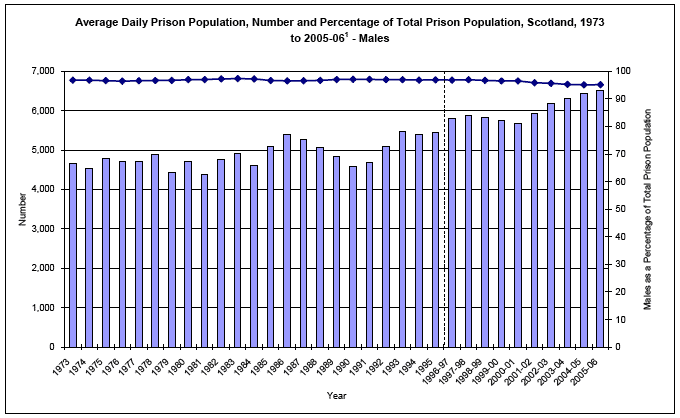
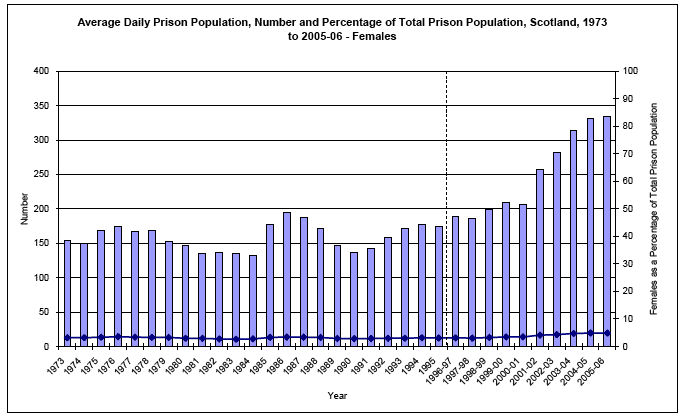
Source: Prison Statistics Scotland
Note: 1. Figures from 1996-97 onwards are for financial rather than calendar years.
Publications
Social Focus on Women and Men 2002 http://www.scotland.gov.uk/stats/sfwm/docs/sfwm-00.asp
Prison Statistics Scotland, 2005-06 http://www.scotland.gov.uk/Publications/2006/08/18103613/0
Prison Population: Ethnic Group
On the 30 th June 2005, people from all minority ethnic groups accounted for 2.46% of the total Scottish prison population and this is relatively similar to the proportion of the Scottish adult population as a whole who are from minority ethnic groups (1.77% according to the 2001 Census). There is relatively little difference between minority ethnic groups, however the largest group is Pakistani (0.61%), followed by Other ethnic group (0.47%) and Black-Caribbean (0.36%). The smallest minority ethnic group is Bangladeshi (0.03%), followed by Other Asian and Mixed Other (0.04% in for both groups).
Since 2001, there has been relatively little change in the proportion of the Scottish prison population who are from minority ethnic groups.
Scottish Prison Population By Ethnic Group 1 as at 30 June 2001 to 2005
Column Percentages
Ethnic Group |
Scottish Prison Population |
||||
|---|---|---|---|---|---|
Percentage |
|||||
2001 |
2002 |
2003 |
2004 |
2005 |
|
White |
97.88 |
98.41 |
98.24 |
96.93 |
97.54 |
Black-Caribbean |
0.21 |
0.21 |
0.31 |
0.34 |
0.36 |
Black-African |
0.37 |
0.09 |
0.09 |
0.20 |
0.27 |
Black-Other |
0.21 |
0.23 |
0.20 |
0.24 |
0.33 |
Indian |
0.22 |
0.15 |
0.15 |
0.11 |
0.16 |
Pakistani |
0.43 |
0.47 |
0.57 |
0.76 |
0.61 |
Bangladeshi |
0.03 |
0.00 |
0.03 |
0.04 |
0.03 |
Chinese |
0.16 |
0.03 |
0.05 |
0.04 |
0.15 |
Other Asian |
n/a |
n/a |
n/a |
n/a |
0.04 |
Mixed Other |
n/a |
n/a |
n/a |
n/a |
0.04 |
Other Ethnic Group |
0.50 |
0.40 |
0.37 |
0.45 |
0.47 |
Unknown |
n/a |
n/a |
n/a |
0.88 |
n/a |
All Ethnic Groups |
100.00 |
100.00 |
100.00 |
100.00 |
100.00 |
All Minority Ethnic Groups |
2.12 |
1.59 |
1.76 |
2.20 |
2.46 |
Source: Prison Statistics Scotland
Note: 1. A new prisoner records system was introduced in 2004 resulting in a number of prisoners with an 'Unknown' ethnicity in 2004.
Publications
Analysis of Ethnicity in the 2001 Census - Summary Report http://www.scotland.gov.uk7ff5ee0f-3801-4607-b42e-2fbe7a66bf2d
Prison Statistics Scotland, 2005-06 http://www.scotland.gov.uk/Publications/2006/08/18103613/0
Prison Population: Age Group
On 30 June 2005, just under half (49%) of prisoners were aged between 25 and 39 years, 29% were under 25 years, 14% were aged between 40 and 49 and just 7% were aged over 50 years .
On the 30 June 1999, there were more younger prisoners, 35% were aged under 25 years. There were also smaller numbers of older prisoners, only 11% were aged between 40 and 49 years and just 6% were aged over 50.
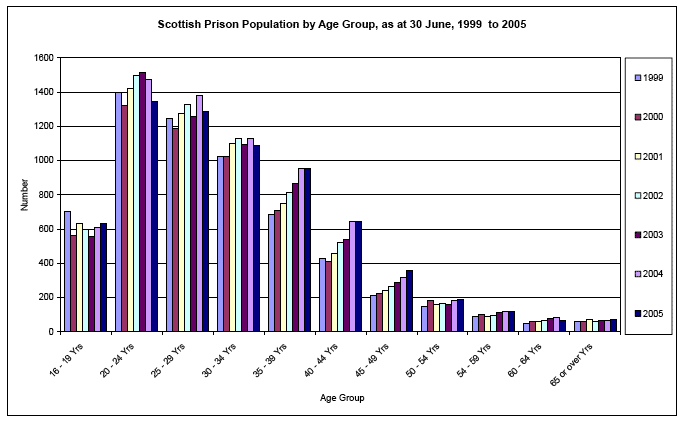
Source: Prison Statistics Scotland
Publication
Prison Statistics Scotland, 2005-06 http://www.scotland.gov.uk/Publications/2006/08/18103613/0
Fine Default
Fine Default: Gender
In 2005-06, 92% (5,734) of fine default receptions were for male offenders, with 8% (479) being female offenders. The number of fine default receptions has decreased for both male offenders (down 34%) and female offenders (down 38%) since 1998-99.
Fine default receptions (like all receptions) count warrants received, not people entering prison, so in some cases a prisoner who is already in custody will ask for outstanding fines to be taken into account. This will result in the receipt of a warrant and a fine default reception would be recorded. However, as fine default sentences are served concurrently (at the same time) as any other sentences, no extra time in prison would be served and the average daily prison population would be unchanged. The figures on entries to prison purely for fine default only count people entering prison from the community with a warrant for fine default only and no other warrant.
It should also be noted that sentences for fine default tend to be very short, therefore only a fairly small number of people are in prison for this reason at any given time. Therefore although the numbers outlined below seem high, they have little effect on the overall size of the prison population. In 2005-06, the average daily prison population of fine defaulters was 53.
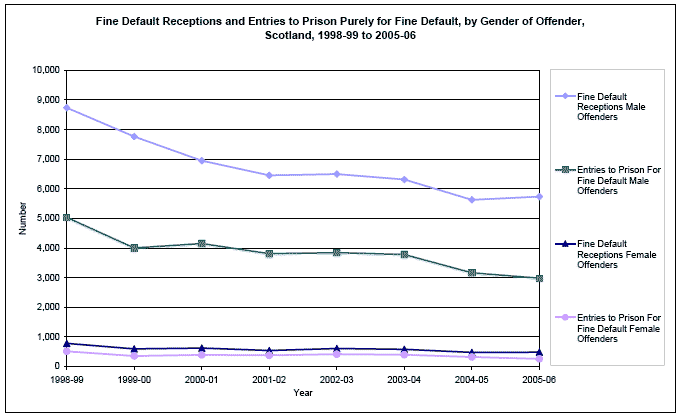
Source: Prison Statistics Scotland
Publications
Social Focus on Women and Men 2002 http://www.scotland.gov.uk/stats/sfwm/docs/sfwm-00.asp
Prison Statistics Scotland, 2004-05 http://www.scotland.gov.uk/Publications/2005/08/18102211/22138
Homicide
Homicide Victims: Gender
Scottish homicide victims are far more likely to be male than female and male homicide victims are slightly more likely to be killed with a sharp instrument than female victims.
Eighty per cent of homicide victims in Scotland were male (110) in 2004-05 as at November 2005. Of these 55% (61) were killed with a sharp instrument. Twenty per cent of homicide victims in this period were female (27), of whom 41% (11) were killed with a sharp instrument.
It should be borne in mind that the number of homicide victims is small and tends to fluctuate year on year for both males and females, as do the number of victims killed with a sharp instrument.
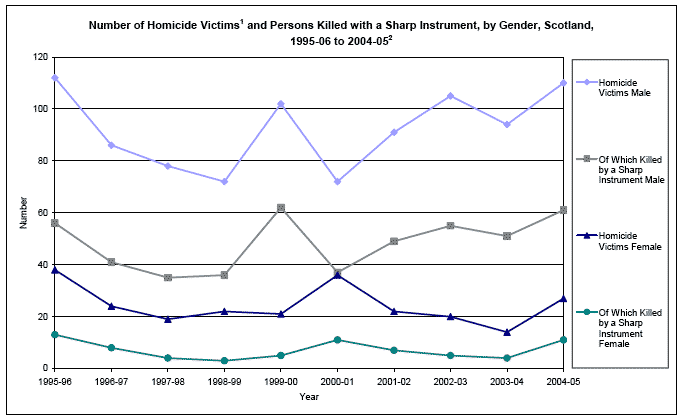
Source: Scottish Executive Justice Department - Scottish Homicide Index
Notes: 1. As at 28 th November 2005 recorded as homicide.
2. Figures for 1995-96 include 17 victims (5 males and 12 females) of the Dunblane shootings.
Publications
Social Focus on Women and Men 2002 http://www.scotland.gov.uk/stats/sfwm/docs/sfwm-00.asp
Homicide in Scotland http://www.scotland.gov.uk/Topics/Statistics/Browse/Crime-Justice/PubHomicide
Homicide Perpetrators: Age
The number of homicide perpetrators (per 100,000 head of population) is highest for those aged between 16 and 29 years (12 per 100,000 head of population) in 2004-05 and is markedly lower for all other age groups.
It should be borne in mind that the number of homicide perpetrators is small and tends to fluctuate year on year.
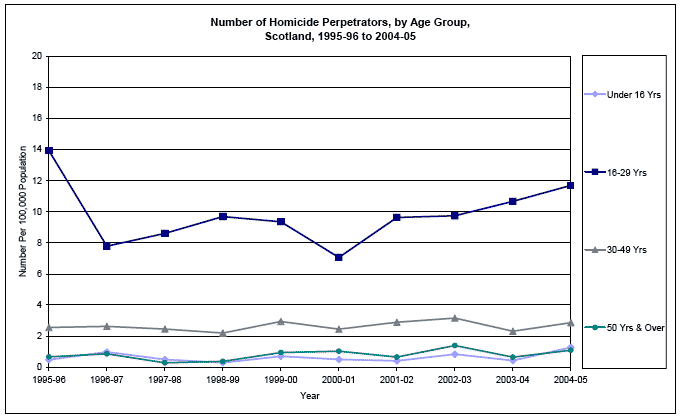
Source: Scottish Executive Justice Department - Scottish Homicide Index
General Register Office for Scotland ( GROS) - Mid Year Population Estimates
Publication
Homicide in Scotland http://www.scotland.gov.uk/Topics/Statistics/Browse/Crime-Justice/PubHomicide
Youth Crime
Youth Crime: Gender
Most children between the ages of 8 and 16 years who are alleged to have committed offences are dealt with by the Children's Hearings System.
Seventy-five per cent of children referred to the Children's Reporter on offence grounds were male and 25% were female in 2004-05.
The number of male children referred on offence grounds has increased by 25% from 10,545 in 1994 to 13,151 in 2004-05, whilst for females it has increased by 51% from 2,852 to 4,320.
It should be noted that children may also be referred to the Children's Reporter on non-offence grounds and these form the majority of referrals.
The following data are not National Statistics.
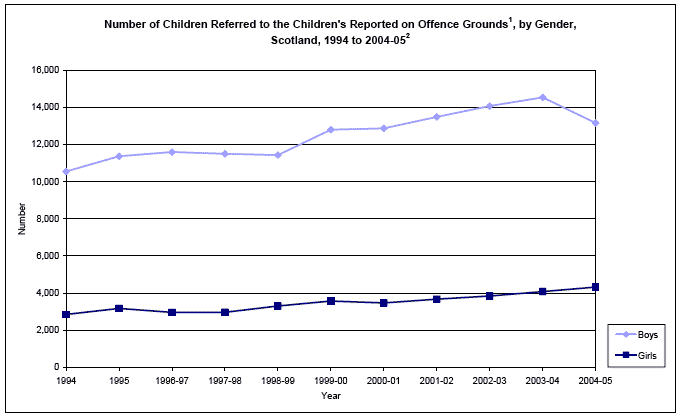
Source: Scottish Children's Reporter Administration ( SCRA)
Notes: 1. Children are referred to the Children's Reporter for allegedly offending under section 52(2)(i) of The Children (Scotland) Act 1995.
2. Data from 1999-00 onwards is 'on receipt' in the reporting years. Data from previous years is 'on disposal' in the reporting year.
Publications
Scottish Youth Justice: Performance Update Report 2004-05 http://www.scra.gov.uk/documents/Scottish_Youth_Justice_Annual_Update_Report_v00h1.pdf
Scottish Children's Reporter Administration Annual Report 2004-05 www.scra.gov.uk
Youth Crime: Age
Offence referrals to the Children's Reporter are most likely to occur for children aged 15 years.
Since 1999-00, offence referrals have increased for all children aged between 8 and 17 years, with the largest increase being for children aged 15 (up 24%), followed by those aged 13 years (up 23%).
It should be noted that the number of young people aged 16 or 17 years who are referred is relatively small. This is because most offenders in this age group are dealt with by the adult Criminal Justice System.
The following data are not National Statistics.
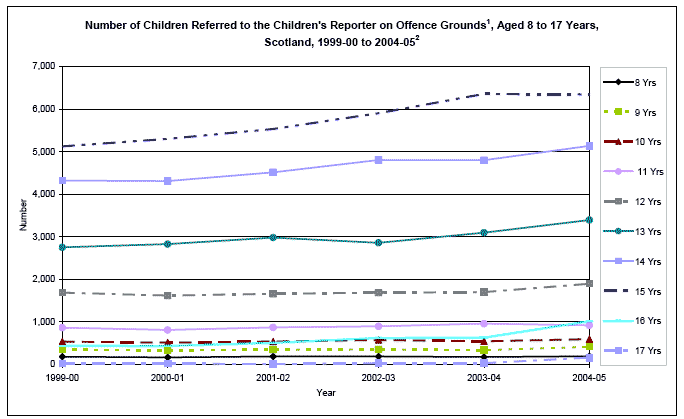
Source: Scottish Children's Reporter Administration ( SCRA)
Notes: 1. Children are referred to the Children's Reporter for allegedly offending under section 52(2)(i) of The Children (Scotland) Act 1995.
2. Data from 1999/00 onwards is 'on receipt' in the reporting years. Data from previous years is 'on disposal' in the reporting year.
Publications
Scottish Youth Justice: Performance Update Report 2004-05 http://www.scra.gov.uk/documents/Scottish_Youth_Justice_Annual_Update_Report_v00h1.pdf
Scottish Children's Reporter Administration Annual Report 2004-05 www.scra.gov.uk
Sentences Imposed
Sentences Imposed: Gender
Over 60% of all convictions for both male and female adults resulted in financial penalty. Thirteen per cent of all male convictions resulted in a custodial sentence in 2004-05, compared to 6% of all female convictions. A further 13% of both male and female convictions resulted in a community sentence, whilst 'Other Sentences' accounted for 10% of all male convictions and 19% of all female convictions.
Since 1995-96 the number of convictions resulting in financial penalty has decreased steadily for both males and females. Conversely, there has been a steady rise in the proportion of convictions resulting in a community sentence for both males and females which, in part, can be explained by the introduction of new types of community sentences that have been rolled out nationally over the past decade.
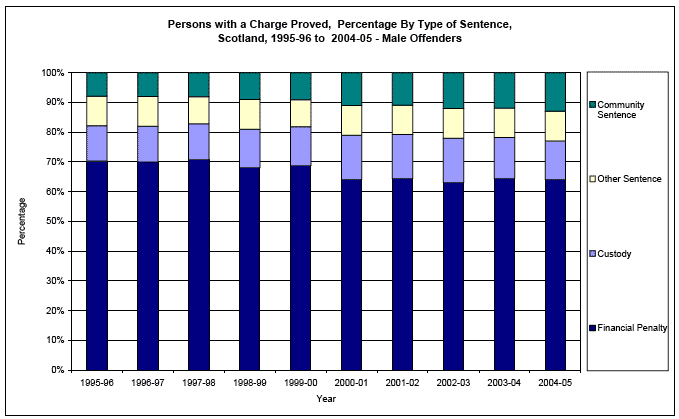
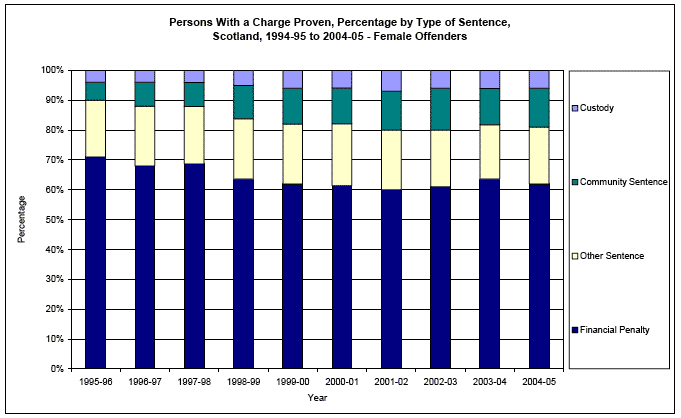
Source: Scottish Executive Justice Department Court Proceedings Database
Publications
Social Focus on Women and Men 2002 http://www.scotland.gov.uk/stats/sfwm/docs/sfwm-00.asp
Criminal Proceedings in Scottish Courts, 2004/05 (Published 2006) http://www.scotland.gov.uk/Publications/2006/04/25104019/0
There is a problem
Thanks for your feedback